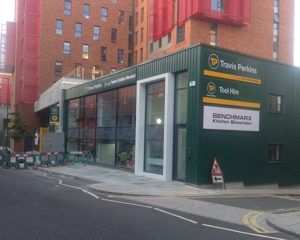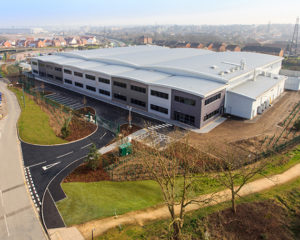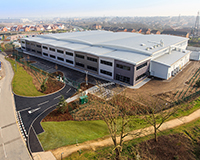
Industrial space and residential don’t make natural bedfellows but market pressures means the property industry is re-evaluating the relationship between the two sectors – and others.
With intense competition from higher value uses, industrial and logistics occupiers are being squeezed out of the market, particularly in urban areas.
London is a prime example of how acute the problem of finding space for sheds has become. In February, Turley Economics and Sustainability launched the Keep London Working report. Commissioned by SEGRO, the report highlights how the capital is losing more than 260 acres of industrial land per year.
The report predicts that at the current rate of decline, the GLA’s release of industrial land, which was expected to completed by 2031, could be reached later this year.
“This is putting huge pressure on logistics operators at a time when they are trying to respond to rising demand,” says Turley’s head of logistics, Amy Gilham.
Just as land supply shrinks, urban logistics is experiencing unprecedented demand, fuelled by ecommerce and last mile delivery. London’s population is forecast to increase from 8.7m to over 10m by 2031 and the effective delivery of goods will play a vital role in the capital’s future growth.
“New homes and logistics operations are vying for the same land and co-location seems an obvious solution in allowing them to both be in optimal locations,” says Gilham.
Developers are already exploring the potential of co-location. SEGRO is mixing residential and logistics at two major regeneration sites (see below) and Royal Mail plans to earmark part of its site at Mount Pleasant, EC1, for residential-led mixed-use development.
Paul Weston, senior vice president at Prologis, says: “We’ll continue to see more land lost to other uses and must explore how these different elements can sit alongside each other.”
In Dartford, Kent, Prologis is transforming 264 acres of brownfield land into mixed-use scheme The Bridge, where 1.8m sq ft of office, science park and industrial space will be integrated with 1,500 new homes.

Weston says: “It just requires careful master-planning in looking at where you position the yards and car parks, while mitigating noise with features such as acoustic fences. Engineering business SEM located right opposite some housing. When we put in for planning residents were up in arms. Yet the building is very well insulated, it looks attractive and none of their fears materialised.”
This trend of co-location may help address land shortage, but if industrial and logistics operations are to be fully integrated into the urban landscape, many argue the next logical step is vertical integration.
Len Rosso, head of industrial and logistics at Colliers International, says: “In highly populated urban centres we need to integrate a greater variety of occupiers into mixed-use schemes where you might see logistics on the ground floor of a building and residential above.”
But such close integration will bring with it a whole host of challenges and some question whether it may prove a step too far.
Weston says: “Residential and logistics wouldn’t make easy bedfellows. As long as there are other places where they can get hold of land, I think occupiers will stick to the type of arrangements they are used to.”
Cushman & Wakefield logistics and industrial partner David Binks agrees: “There would certainly be an element of bad neighbourliness with residents concerned about issues such as noise and vehicle movement. There are also potential restrictions for the logistics occupier’s operations.”
But Tuffin Ferraby Taylor partner, Seth Love-Jones, argues: “Something has to be done to boost the supply of space, or poor old logistics will be wiped off the face of the urban landscape.”
He adds: “There are obstacles, but none of them are insurmountable. You can look at using different entrance for different uses, find ways of mitigating problems of noise and traffic and make the space more visually appealing.”
Love-Jones points to the example of hotels, which manage to deal with 24-hour delivery requirements in the same building as sleeping customers.
Issues over noise can be met through requirements such as switching off engines and bleepers at night, using triple glazing and thinking about the orientation of living space.
“If buildings are well insulated then it would be no different to living next to a busy road,” says Rosso. “In London a lot of people already live next to busy roads, train stations or bus depots. For years we’ve had residential above retail and I’d argue that living above a 24-hour Sainsbury’s would be far more disruptive than being above logistics or trade space.”
Rosso says the model will become popular with developers and occupiers alike. He cites an example in Camden where in 2014 Unite delivered a 583-unit student housing scheme above a Travis Perkins timber yard.
Travis Perkins regional director for London, Danny Rossiter, says: “Land is at a premium so it made sense to find a different solution.
“As this is central London, with so much buzz almost 24/7, there have been no complaints from any of the student residents about our operations causing noise or congestion.”
Others are likely to follow suit. CBRE executive director Simon Milner says: “We’re exploring possibilities with developers and I think we’ll see some very challenging and exciting designs. They are looking at things like using platforms to sit residential above logistics, or even putting the logistics element underground.”
Savills’ industrial and logistics director, Richard Sullivan says: “Architects and consultants will grapple with the challenges, but there is an appetite to integrate uses better, particularly in high-value areas of London. Hopefully it will culminate in some very innovatively-built product.”
Thinking outside the box

SEGRO’s chief operating officer Andy Gulliford believes combining different uses is critical in tackling land supply shortages.
“We’re exploring the innovative idea of mixing residential and logistics and horizontal mixed-use is really the order of the day,” says Gulliford. “There are concerns about people living next door to 24/7 operations, but with good design these issues can be addressed.”
The developer is doing just that on the former Nestlé site in Hayes, Middlesex, where it has teamed up with residential partner Barratt London. Once planning is secured, Barratt will acquire around two thirds of the site from SEGRO to build 1,100 homes. Meanwhile, on the adjacent land, SEGRO will deliver around 250,000 sq ft of urban logistics.
Gulliford says careful design should help overcome any issues between the two neighbours. The residential element will face inwards to its own amenities and green space, with both parts of the site having their own access routes.
Barratt and SEGRO are also teaming up to deliver around 1,000 new homes and up to 500,000 sq ft of logistics at the Meridian Water development in Enfield, where similar design principles are likely to be followed.
Meanwhile, as well as looking at greater intensification of use through the development of multi-level warehousing, Gulliford says SEGRO is assessing how residential might sit beneath logistics space at sites such as Park Royal.
Gulliford says: “If you’re vertically stacking you need to address any challenges by covering the logistics space over and using a platform to accommodate the residential element above.”
Gulliford sees the model working particularly well with build-to-rent schemes, creating two investment assets in one site.
As well as convincing investors and occupiers of the merits, Gulliford concedes it will take a shift in focus from the planners.
He says: “We are calling for the GLA and London boroughs to think more innovatively and would like to see the introduction of an industrial sounding board to input into policy. There is some work to do, but we’re encouraged by the conversations we’ve had so far.”











